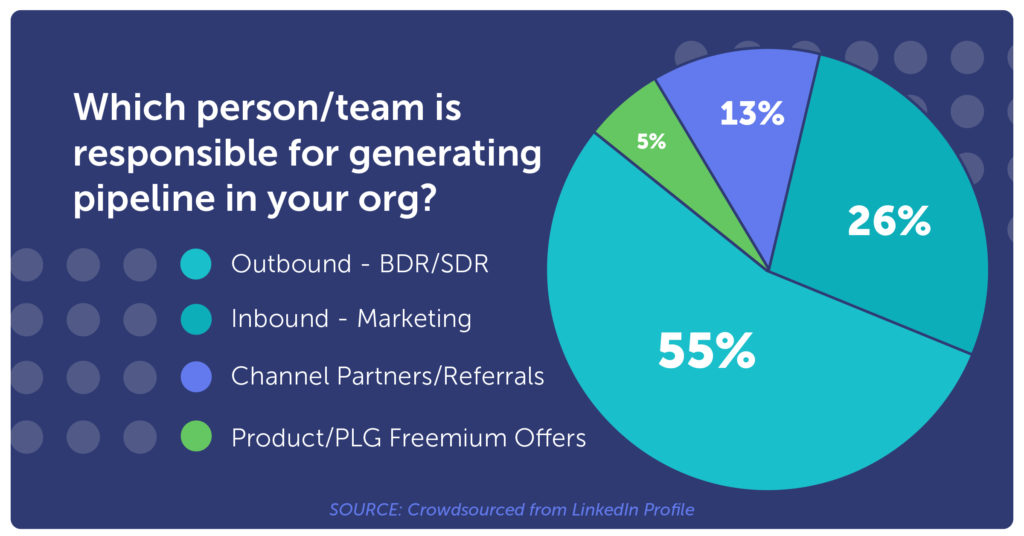We are all facing tough macroeconomic times – revenue isn’t what we anticipated for this quarter or the last one. Now what? If there’s a revenue issue, we’re often quick to point fingers.
Who is responsible? Is it your sales team that’s not moving the pipeline fast enough to convert into deals? Or what about marketing not generating enough pipeline? Or are partners not sending enough leads?
There are so many questions, and it’s easy for inexperienced companies to place blame on one team or department. The sage and experienced companies know the magic mantra: generating pipeline is a team sport!
Let’s Look at the Data
I recently asked my LinkedIn network who’s responsible for pipeline generation in their organization. Their responses were divided, with over half of the respondents favoring outbound sales.

I was honestly surprised to see the outbound contribution being 2x larger than inbound / marketing. I was expecting almost an equal split. After all, sales and marketing teams work in tandem to generate pipeline. At the same time, it’s great to see the mix of channel and product driving the pipeline as well.
Huddle Up and Collaborate
When companies struggle with pipeline generation, it often boils down to departments being siloed. Each department is in its lane, working towards its own goals but not communicating with one another.
Although, pipeline generation works differently for every company, product, market, feature, and persona. There is no universal fail-proof approach. However, a few aspects apply to most scenarios and can be adapted to fit your organization’s needs. While the game may not be the same for everyone, the fundamentals of the sport remain evergreen.
The best-run companies believe in the mantra that the pipeline is everyone’s responsibility – not just your sales or marketing teams. Each member of the company contributes to the pipeline; including product, partnership teams, and yes, executives.
Football season is in full swing, so let’s use that analogy!
Your Playbook: A Healthy Product-Market Fit
You may be wondering what does product-market fit have to do with pipeline generation? If you are starting a new business OR a new product line, establish your product-market fit before worrying about generating pipeline.
The question then is who validates the product market fit? I have a pretty strong opinion on this. In a startup, it’s the founding team and for the new product line, it’s your product leader in partnership with the founder (or the sponsor of the product idea).
You can’t afford to outsource or assign someone new in the sales/marketing team to validate product market fit. You’d be losing time, money, and morale and most likely not getting results.
You should know and be confident in your product-market fit before generating pipeline and trying to close deals. While the process may take longer and go slower, when you go to generate demand, you’ll already be armed with your early adopters and a few happy customers, testimonials, and maybe even a case study or two. Being genuinely aligned across departments will be vital in your GTM efforts.
Your Quarterback: The Growth Hackers
Once you know that you have a healthy product market fit and resonate with the right audience, the next logical step is identifying whitespace and gaps where your organization can execute where other industry players (your competitors) aren’t. This role is best played by a team that has the right mix of sales, marketing, and product experts.
When we “hack growth,” we often rely on small teams that need to maximize their efforts and inform other team members of the play. What are we doing, and what’s to come? When do we start?
Companies can do this by focusing on generating content that is the voice of the customer. Have your account managers invite your customers to speak about the problems they see in the industry, their expertise, and their experiences. From that, marketing teams can maximize that content in all channels, from social to SEO, drawing inbound leads to fuel the pipeline. These customer experiences can also be used as collateral for outbound sales teams, demonstrating the benefits and use cases.
Your Center: Revenue Operations
I can’t emphasize the importance of revenue operations enough. Oftentimes companies (full transparency, us included) deprioritize the investment in revenue operation function.
Your Revenue Operations team should focus on ensuring that your systems are integrated, and your leads flow with the proper attribution. They’ll be the ones maximizing your sales efficiency.
This team brings efficiency to your GTM team by integrating revenue systems to ensure the right flow of data, analyzing data for trends, helping prioritize accounts with the highest likelihood of closing, and bringing an unbiased funnel dataset to the executive team
Your Trainer: Sales Enablement
Your sales team should be enabled, so they are effective in selling as fast as possible. Your sales enablement team will be onboarding new revenue team members and ensuring they keep up with their training and have all they need to succeed. Your players need to be at their best to compete and win.
Successful teams are developed with proper onboarding, and with continuous training, not one-off seminars. In fact, ongoing training results in 50% higher net sales per rep – contributing to your bottom line.
Your Fanbase: Partnership
What is a sport without its supporters? Who gets the crowd going and chanting for your teams? That’s where partnership teams come in. Your partnership teams are the ones who create the ecosystem that promotes your brand and generates the buzz.
Partnership teams can then generate referral business. By sourcing new customers and engaging your team members, the partnership team can convey to the community how excellent your solution is and encourage others to come on board. The more people rooting for you, the better.
Your Coach: The Executive Team
Who better to serve as a coach than your executive team? They are the ones who encourage and promote strengths and identify internal areas for improvement. Your executive team is the trusted source for victory speeches or discussing what the team can do better to remain competitive.
They are incredible advocates who speak at different levels in the community to establish thought leadership boosting brand awareness, morale, and revenue opportunities.
Together we are a part of ONE team working towards the same goal – building that pipeline!




